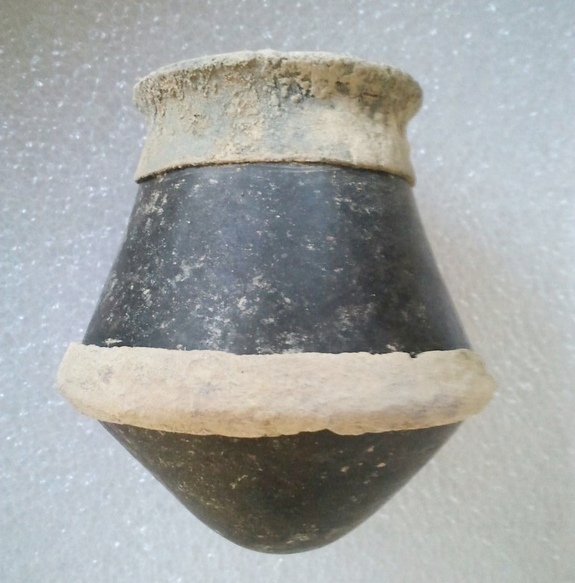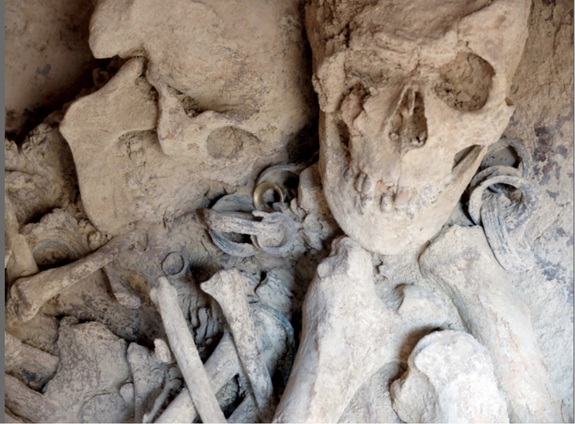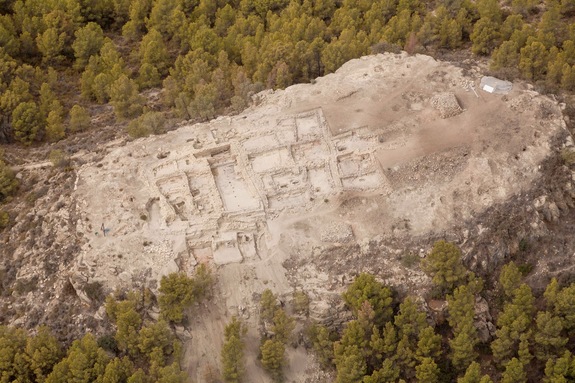It looks like you're using an Ad Blocker.
Please white-list or disable AboveTopSecret.com in your ad-blocking tool.
Thank you.
Some features of ATS will be disabled while you continue to use an ad-blocker.
Bronze age palace and grave goods discovered at the archaeological site of La Almoloya in Pliego, Mu
page: 16
share:
Universitat Autònoma de Barcelona
Archaeologists from the Universitat Autònoma de Barcelona (UAB) have discovered a palatial construction with an audience hall which makes up the first specifically political precincts built in continental Europe. A prince's tomb in the subsoil contains the largest amount of grave goods from the Bronze Age existing in the Iberian Peninsula. Some of the most outstanding items include a silver diadem of great scientific and patrimonial value, the only one conserved from that era in Spain, as well as four golden and silver ear dilators.
Excavations conducted in August by the researchers of the UAB's Department of Prehistory Vicente Lull, Cristina Huete, Rafael Micó y Roberto Risch have made evident the unique archaeological wealth of La Almoloya site, located in Pliego, Murcia. The site was the cradle of the "El Argar" civilisation which lived in the south-eastern part of the Iberian Peninsula during the Bronze Age.
La Almoloya is located on a steep plateau which dominated an extensive region. This strategic and privileged position gave way to over six centuries of occupation, from 2200 to1550 before our common era. The site was discovered in 1944 by Emeterio Cuadrado and Juan de la Cierva.
The findings indicate that La Almoloya was a primary centre of politics and wealth within the political territory of El Argar -- located a few hundred kilometres to the south in Almeria -- and sheds new light on the politics and gender relations in one of the first urban societies of the West.
A Palatial Building and new Argaric Style
The discoveries made by the archaeological team include an urban tissue made up of fully equipped buildings, as well as dozens of tombs, most of them including grave goods. According to archaeologists, this urban tissue, as well as the solidity and mastery of the construction techniques, are unique samples of prehistoric constructions in continental Europe.
The excavations indicate that the La Almoloya plateau, of 3,800 metres square, was densely populated and included several residential complexes of some 300 square metres, with eight to twelve rooms in each residence.
The buildings' walls were constructed with stones and argamasa, and covered with layers of mortar. Some parts contain stucco decorated with geometric and naturalistic motifs, a novelty which represents the discovery of an Argaric artistic style.
www.sciencedaily.com...
Klik^ for much more life may have been much more sophisticated in Bronze age Iberia than previously thought I didn't see any exact date maybe they will give it later.
edit on 14-10-2014 by Spider879 because: (no reason given)
A Princely Tomb with Objects of Great Value
Of the fifty tombs excavated from under the La Almoloya buildings, one stands out in particular. Located in a privileged area, next to the main wall of the hall, the tomb reveals the remains of a man and woman buried with their bodies in a flexed position and accompanied by some thirty objects containing precious metals and semi-precious stones.
What do you suppose they mean by "flexed position"? (I bolded it. Just so people know it wasnt that way in the actual article in the link)
a reply to: Spider879
Sorry beat you to it spider
www.abovetopsecret.com...
Sorry beat you to it spider
www.abovetopsecret.com...
originally posted by: punkinworks10
Found some pics,
A silver rimmed ceramic cup
The grave of the pair.
The "civic center"
and the site
edit on 15-10-2014 by punkinworks10 because: (no reason given)
originally posted by: 3n19m470
A Princely Tomb with Objects of Great Value
Of the fifty tombs excavated from under the La Almoloya buildings, one stands out in particular. Located in a privileged area, next to the main wall of the hall, the tomb reveals the remains of a man and woman buried with their bodies in a flexed position and accompanied by some thirty objects containing precious metals and semi-precious stones.
What do you suppose they mean by "flexed position"? (I bolded it. Just so people know it wasnt that way in the actual article in the link)
By flexed , they mean the bodies were curled into am almost fetal position, before they were buried in a jar.
new topics
-
Sunak spinning the sickness figures
Other Current Events: 19 minutes ago -
Nearly 70% Of Americans Want Talks To End War In Ukraine
Political Issues: 30 minutes ago -
Late Night with the Devil - a really good unusual modern horror film.
Movies: 2 hours ago -
Cats Used as Live Bait to Train Ferocious Pitbulls in Illegal NYC Dogfighting
Social Issues and Civil Unrest: 3 hours ago -
The Good News According to Jesus - Episode 1
Religion, Faith, And Theology: 5 hours ago -
HORRIBLE !! Russian Soldier Drinking Own Urine To Survive In Battle
World War Three: 7 hours ago -
Bobiverse
Fantasy & Science Fiction: 10 hours ago -
Florida man's trip overseas ends in shock over $143,000 T-Mobile phone bill
Social Issues and Civil Unrest: 10 hours ago
top topics
-
Florida man's trip overseas ends in shock over $143,000 T-Mobile phone bill
Social Issues and Civil Unrest: 10 hours ago, 8 flags -
SETI chief says US has no evidence for alien technology. 'And we never have'
Aliens and UFOs: 14 hours ago, 7 flags -
Cats Used as Live Bait to Train Ferocious Pitbulls in Illegal NYC Dogfighting
Social Issues and Civil Unrest: 3 hours ago, 7 flags -
This is our Story
General Entertainment: 17 hours ago, 4 flags -
Former Labour minister Frank Field dies aged 81
People: 12 hours ago, 4 flags -
Bobiverse
Fantasy & Science Fiction: 10 hours ago, 3 flags -
Late Night with the Devil - a really good unusual modern horror film.
Movies: 2 hours ago, 2 flags -
HORRIBLE !! Russian Soldier Drinking Own Urine To Survive In Battle
World War Three: 7 hours ago, 2 flags -
The Good News According to Jesus - Episode 1
Religion, Faith, And Theology: 5 hours ago, 0 flags -
Nearly 70% Of Americans Want Talks To End War In Ukraine
Political Issues: 30 minutes ago, 0 flags
6




